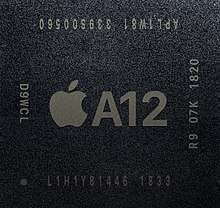Apple A12
 | |
| Produced | From September 12, 2018 to present |
|---|---|
| Designed by | Apple Inc. |
| Common manufacturer(s) | |
| Max. CPU clock rate | to 2.49 GHz[2] |
| Min. feature size | 7 nm[3][4] |
| Instruction set | A64 |
| Microarchitecture | ARMv8‑A-Compatible |
| Product code | APL1W81[5] |
| Cores | Hexa-core (2× high performance Vortex + 4× high efficiency Tempest)[3][6] |
| L1 cache | 128 KB instruction, 128 KB data |
| L2 cache | 8 MB |
| Predecessor | Apple A11 Bionic |
| GPU | Apple-designed 4 core[3][6] |
| Application | Mobile |
The Apple A12 Bionic is a 64-bit ARM-based system on a chip (SoC) designed by Apple Inc.[7] It first appeared in the iPhone XS, XS Max and XR which were introduced on September 12, 2018.[7][4] It has two high-performance cores which are claimed to be 15% faster and 40% more energy-efficient than the Apple A11 and four high-efficiency cores which are claimed to use 50% less power than the energy-efficient cores in the A11.[7][6]
Design
The A12 features an Apple-designed 64-bit ARMv8.3-A six-core CPU, with two high-performance cores running at 2.49 GHz called Vortex and four energy-efficient cores called Tempest.[3][4] The A12 also integrates an Apple-designed four-core graphics processing unit (GPU) with 50% faster graphics performance than the A11.[3][7] The A12 includes dedicated neural network hardware that Apple calls a "Next-generation Neural Engine."[8] This neural network hardware has eight cores[6] and can perform up to 5 trillion operations per second.[3][4]
The A12 (internally called the T8020) is manufactured by TSMC[1] using a 7 nm[4] FinFET process, the first to ship in a smartphone,[3][1] and it contains 6.9 billion transistors.[1] The die size of the A12 is 83.27 mm2, 5% smaller than the A11.[9] It is manufactured in a package on package (PoP) together with 4 GB of LPDDR4X memory in the iPhone XS[5] and XS Max[9] and 3 GB of LPDDR4X memory in the iPhone XR. The ARMv8.3 instruction set it supports brings a significant security improvement in the form of pointer authentication, which mitigates exploitation techniques such as those involving memory corruption, Jump-Oriented-Programming, and Return-Oriented-Programming.[10]
Products that include the Apple A12 Bionic
See also
- Apple-designed processors, the range of ARM-based mobile processors designed by Apple for their consumer electronic devices
References
- 1 2 3 4 Summers, Nick (September 12, 2018). "Apple's A12 Bionic is the first 7-nanometer smartphone chip". Engadget. Retrieved September 12, 2018.
- ↑ "iPhone XS Benchmarks - Geekbench Browser". Geekbench. Retrieved September 22, 2018.
- 1 2 3 4 5 6 7 Smith, Ryan (September 12, 2018). "Apple Announces the 2018 iPhones: iPhone XS, iPhone XS Max, & iPhone XR". AnandTech. Retrieved September 12, 2018.
- 1 2 3 4 5 "iPhone Xs and iPhone Xs Max bring the best and biggest displays to iPhone" (Press release). Apple. September 12, 2018. Retrieved September 12, 2018.
- 1 2 "iPhone XS and XS Max Teardown". iFixit. September 21, 2018. Retrieved September 21, 2018.
- 1 2 3 4 "A12 Bionic". Apple. September 12, 2018. Retrieved September 12, 2018.
- 1 2 3 4 "Apple introduces iPhone XR" (Press release). Apple. September 12, 2018. Retrieved September 12, 2018.
- ↑ "iPhone XS - Technical Specification". Apple. September 12, 2018. Retrieved September 12, 2018.
- 1 2 Yang, Daniel; Wegner, Stacy (September 21, 2018). "Apple iPhone Xs Max Teardown". TechInsights. Retrieved September 21, 2018.
- ↑ Levin, Jonathan (September 15, 2018). "iPhone Xs, Xr... And, one more thing..." NewOSXBook.com. Retrieved September 15, 2018.